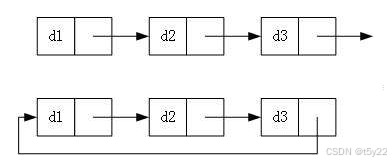阅读量:0
一、链表的概念及结构
1.链表的概念
概念:链表是一种物理存储结构上非连续、非顺序的存储结构,数据元素的逻辑顺序是通过链表中的指针链接次序实现的 。
2.链表的结构
一般讲的链表包括数据域和指针域:
二、链表的种类
实际中链表的结构非常多样,由以下三组类型自由组合可得8种链表结构:
1.单向、双向:

2.带头、不带头:

3.循环、非循环:

虽然有这么多类型,但我们最长使用的就是以下两种:
在此我们只实现这两种链表
三、单链表的实现
1.自定义链表结点struct SListNode
typedef int SLTDateType; typedef struct SListNode { SLTDateType data; struct SListNode* next; }SListNode;2.链表打印数据SListPrint
//打印 void SListPrint(SListNode* plist) { if (plist == NULL) return; while (plist) { printf("%d->", plist->data); plist = plist->next; } }3.链表创建结点BuyListNode
//创建节点 SListNode* BuySListNode(SLTDateType x) { SListNode* new_node = (SListNode*)malloc(sizeof(SListNode)); if (new_node == NULL) { perror("malloc fail"); return NULL; } new_node->data = x; new_node->next = NULL; return new_node; }4.链表尾部插入数据SListPushBack
//尾插 void SListPushBack(SListNode** pplist, SLTDateType x) { //无节点 if (*pplist == NULL) { (*pplist) = BuySListNode(x); } //有节点 SListNode* tail = *pplist; while (tail->next) { tail = tail->next; } tail->next = BuySListNode(x); }5.链表头部插入数据SListPushFront
//头插 void SListPushFront(SListNode** pplist, SLTDateType x) { SListNode* new_node = BuySListNode(x); new_node->next = *pplist; *pplist = new_node; }6.链表尾部删除数据SListPopBack
//尾删 void SListPopBack(SListNode** pplist) { //空链表 if ((*pplist) == NULL) return; //一个节点 if ((*pplist)->next == NULL) { SListNode* tmp = *pplist; free(tmp); tmp = NULL; } //多个节点 else { SListNode* cur = *pplist; SListNode* next = cur->next; //找尾 while (cur->next->next) { cur = next; next = next->next; } free(next); cur->next = NULL; } }7.链表头部删除数据SListPopFront
//头删 void SLPopFront(SListNode** pplist) { //没有节点 if ((*pplist) == NULL) return; //一个节点 //多个节点 SListNode* tmp = *pplist; *pplist = (*pplist)->next; free(tmp); tmp = NULL; }8.链表查找数据
//查找 SListNode* SListFind(SListNode* plist, SLTDateType x) { SListNode* cur = plist; while (cur) { if (cur->data == x) { return cur; } cur = cur->next; } return NULL; }9.链表在pos位置之后插入数据
// 单链表在pos位置之后插入x void SListInsertAfter(SListNode* pos, SLTDateType x) { SListNode* newnode = BuySListNode(x); //在非尾节点插入 if (pos->next != NULL) { newnode->next = pos->next; pos->next = newnode; } else { SListPushBack(&pos, x); } }10.删除pos位置之后的值
// 单链表删除pos位置之后的值 void SListEraseAfter(SListNode* pos) { if (pos->next == NULL) { printf("erroe"); return; } SListNode* del = pos->next; pos->next = del->next; free(del); del = NULL; }11.销毁链表
//销毁链表 void SLTDestroy(SListNode** pphead) { if (*pphead == NULL) return; SListNode* next = (*(pphead))->next; while (*pphead) { //销毁 SListNode* del = *pphead; free(del); del = NULL; //迭代 *pphead = next; if(next) next = next->next; } }四.带头双向循环链表的实现
1.自定义链表结点 ListNode
typedef int LTDataType; typedef struct ListNode { LTDataType _data; struct ListNode* _next; struct ListNode* _prev; }ListNode;2.创建新节点
//创建新节点 ListNode* BuyLTNode(LTDataType x) { ListNode* newnode = (ListNode*)malloc(sizeof(ListNode)); if (newnode == NULL) { perror("malloc fail"); return NULL; } newnode->_data = x; newnode->_next = NULL; newnode->_prev = NULL; return newnode; }3.创建一个新链表,返回头结点
// 创建返回链表的头结点. ListNode* ListCreate() { ListNode* Phead = BuyLTNode(-1); Phead->_next = Phead; Phead->_prev = Phead; return Phead; }4.打印链表
//打印链表 void ListPrint(ListNode* pHead) { if (pHead == NULL) return; ListNode* cur = pHead->_next; printf("pHead <=> "); while (cur!=pHead) { printf("%d <=> ", cur->_data); cur = cur->_next; } }5.在pos之前插入值为x节点
//在pos前插入 void ListInsert(ListNode* pos, LTDataType x) { ListNode* pre = pos->_prev; ListNode* newnode = BuyLTNode(x); newnode->_next = pos; pos->_prev = newnode; pre->_next = newnode; newnode->_prev = pre; }6.尾插
//尾插 void ListPushBack(ListNode* pHead, LTDataType x) { ListInsert(pHead, x); }7.头插
//头插 void ListPushFront(ListNode* pHead, LTDataType x) { ListInsert(pHead->_next, x); }8.删除pos位置节点
//删除pos位置的节点 void ListErase(ListNode* pos) { ListNode* pre = pos->_prev; ListNode* next = pos->_next; free(pos); pos = NULL; pre->_next = next; next->_prev = pre; }9.双向链表头删
// 双向链表头删 void ListPopFront(ListNode* pHead) { ListErase(pHead->_next); }10.双向链表尾删
// 双向链表尾删 void ListPopBack(ListNode* pHead) { ListErase(pHead->_prev); }11.查找
// 双向链表查找 ListNode* ListFind(ListNode* pHead, LTDataType x) { ListNode* cur = pHead->_next; while (cur != pHead) { if (cur->_data == x) return cur; cur = cur->_next; } return NULL; } 12.销毁链表
//销毁链表 void ListDestory(ListNode* pHead) { ListNode* cur = pHead->_next; while (cur) { ListNode* next = cur->_next; free(cur); pHead->_next = next; cur = next; } }注:带头双向循环链表的头插头删,尾插尾删直接复用了插入删除代码。

